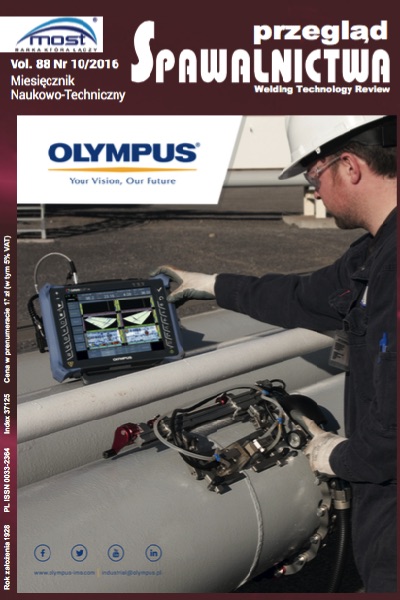Wykorzystanie szumu Barkhausena jako metody pomiaru twardości materiału ferromagnetycznego
##plugins.themes.bootstrap3.article.main##
Abstrakt
Tradycyjne metody pomiaru twardości nie umożliwiają wielokrotnych okresowych pomiarów w tym samym miejscu, ze względu na odkształcenia plastyczne powierzchni spowodowane przez wgłębnik twardościomierza. Potencjalną alternatywą jest wykorzystanie metod magnetycznych badań nieniszczących, do których zaliczany jest pomiar szumu Barkhausena, gdzie taka niedogodność nie występuje, a z przeprowadzonych badań eksperymentalnych wynika, że jest silnie powiązany z mikrostrukturą materiału ferroma-gnetycznego. Celem badań zaprezentowanych w artykule było opracowanie zależności diagnostycznych pomiędzy wielkościami charakterystycznymi szumu Barkhausena a twardością Vickersa HV5. Poszukiwano takich parametrów, dla których wartość współczynnika determinacji R2 korealcji liniowej z twardością HV5 osiągałaby wartość maksymal- ną. Badania wykonano na próbkach płytowych wykonanych ze stali S235 i DC01am.
Using Barkhausen noise as a ferromagnetic material hardness test method
Abstract
Traditional hardness measurement method dont allow for multiple and periodic measurement in the same spot, due plasticall deformation that occur during test. Potential alternative A potential alternative are magnetic non-destructive methods, such as the Barkhausen noise measurement, where this disadvantage is no present and experimental studies prove its strong dependence to microstructure. The aim of the study presented in this paper was to develop diagnostic relationships between characteristic parameters that desribes Barkhausen noise quantitatively and HV5 hardness. The quantities that describe the Barkhausen noise quantitatively for which the highest value of R2 of linear correlation with HV5 hardness was looking for. Tests were performed on plastically deformed samples maded of S235 and DC01am steel grade.
Pobrania
##plugins.themes.bootstrap3.article.details##
Creative Commons CC BY 4.0 https://creativecommons.org/licenses/by/4.0/
Artykuły czasopisma Welding Technology Review (Przegląd Spawalnictwa) publikowane są w otwartym dostępie na licencji CC BY (licencja Creative Commons Uznanie autorstwa 4.0 Międzynarodowe). Licencja CC BY jest najbardziej otwartą dostępną licencją i uważaną za „złoty standard” w formule otwartego dostępu; jest również preferowany przez wielu fundatorów badań. Licencja ta umożliwia czytelnikom kopiowanie i redystrybucję materiału na dowolnym nośniku i w dowolnym formacie, a także zmienianie, przekształcanie lub budowanie na nim materiału, w tym do użytku komercyjnego, pod warunkiem wskazania oryginalnego autora.
Bibliografia
G. Dobmann, I. Altpeter et al.; Barkhausen Noise measurements and related measurements in ferromagnetic materials; in Sensing for material characterization, processing and manufacturing, edited by G. Birnbaum and B. A. Auld, Vol. 1, The American Society for Nondestructive Testing (ASNT), s. 233- 251, 1998.
M. Roskosz, M. Witoś, K. Fryczowski; Studies on magnetic and mechanical properties in plastically deformed ferromagnetic steels; Studies in Applied Electromagnetics and Mechanics, vol. 39 Electromagnetic Nondestructive Evaluation (XVII), IOS Press, s. 271-279, 2014.
M. Blaow, J. Evans, B. Shaw; Effect of hardness and composition gradients on Barkhausen emission in the case of hardened steel, Journal of Magnetism and Magnetic Materials; vol.153, s. 159303, 2006.
L. Piotrowski, B. Augustyniak, M. Chmielewski, I. Tomáš; The influence of plastic deformation on the magnetoelastic properties of the CSN12021 grade steel, Journal of Magnetism and Magnetic Materials, vol. 321, s. 23312335, 2009.
L. R. Padovese, N. Martin, F. Millioz; Time−frequency and timescale analysis of Barkhausen noise signals; Proceedings of the Institution of Mechanical Engineers, Part G: Journal of aerospace engineering, vol. 223, s. 577588, 2009.
D. OSullivan, M. Cotterell, D. A. Tanner, I. Meszaros; Characterisation of ferritic stainless steel by Barkhausen techniques; NDT&E Int., vol. 37, s. 489496, 2004.
P. Vourna, A. Ktena, P. E. Tsakiridis, E. Hristoforou; A novel approach of accurately evaluating residual stress and microstructure of welded electrical steels;
NDT&E Int., vol. 71, s. 3342, 2015.
J. W. Wilson, N. Karimian et al.; Measurement of the magnetic properties of P9 and T22 steel taken from service in power station; Journal of Magnetism and Magnetic Materials, vol. 360, s. 5258, 2014.
M. Vashista, S. Paul; Novel processing of barkhausen noise signal for assessment of residual stress in surface ground components exhibiting poor magnetic respon- se; Journal of Magnetism and Magnetic Materials, vol. 323, s. 25792584, 2011.
